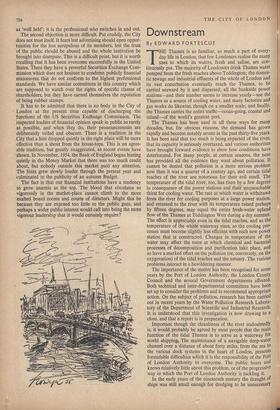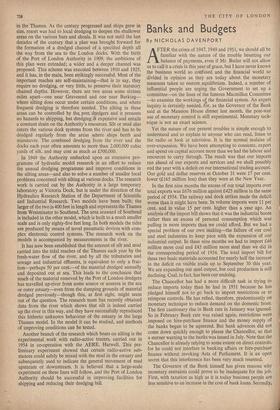Downstream
By EDWARD FORTESCUE THE Thames is so familiar, so much a part of every- day life in London, that few Londoners realise the many uses to which its waters, fresh and saline, are con- tinuously put. The majority of Londoners drink Thames water pumped from the fresh reaches above Teddington; the domes- tic sewage and industrial effluents of the whole of London and its vast conurbation eventually reach the Thames, to be carried seaward by it and dispersed; all the bankside power stations—and their number seems to increase yearly—use the Thames as a source of cooling water, and many factories and gas works do likewise, though on a smaller scale; and finally, the Thames carries the entire traffic—ocean-going, coastal and inland—of the world's greatest port.
The Thames has been used in all these ways for many decades, but, for obvious reasons, the demand has grown rapidly and become notably severe in the past thirty-five years. It has been said that too much is being expected of the river, that its capacity is seriously overtaxed, and various authorities have brought forward evidence to show how conditions have deteriorated. For many people, at certain seasons, the nose has provided all the evidence they want about pollution. It cannot be denied that pollution is a more serious problem now than it was a quarter of a century ago, and certain tidal reaches of the river are notorious for their evil smell. The temperature of the tidal river, too, has risen by a few degrees in consequence of the power stations and then' unquenchable thirst for cooling water. The rate at which water is withdrawn from the river for cooling purposes at a large power station, and returned to the river with its temperature raised perhaps by fifteen degrees, may equal the entire fresh-water upland flow of the Thames at Teddington Weir during a dry summer. The effect is appreciable even in the tidal reaches, and as the temperature of the whole waterway rises, so the cooling pro- cesses must become slightly less efficient with each new power station that is constructed. Changes in temperature of the water may affect the rates at which chemical and bacterial processes of decomposition and purification take place, and so have a marked effect on the pollution (or, conversely, on the oxygenation) of the tidal reaches and the estuary. The various problems interact in a bewildering manner.
The importance of the matter has been recognised for some years by the Port of London Authority, the London County Council and the several Government departments affected. Both technical and inter-departmental committees have been set up to consider the problems and to recommend appropriate action. On the subject of pollution, research has been carried out in recent years by the Water Pollution Research Labora- tory of the Department of Scientific and Industrial Research. It is understood that this investigation is now drawing to a close, and that a report is in preparation.
Important though the cleanliness of the river undoubtedly is, it would probably be agreed by most people that the main function of the tidal Thames is to serve as a waterway for world shipping, The maintenance of a navigable deep-water channel over a distance of about forty miles, from the sea to the various dock systems in the heart of London, presents formidable difficulties which it is the responsibility of the Port of London Authority to overcome. The public hears and knows relatively little about this problem, or of the progressive way in which the Port of London Authority is tackling it. In the early years of the nineteenth century the draught of ships was still small enough for dredging to be unnecessary in the Thames. As the century progressed and ships grew in size, resort was had to local dredging to deepen the shallower areas on the various bars and shoals. It was not until the last decades of the century that a plan was brought forward for the formation of a dredged channel of a specified depth all the way from the sea to the London docks. With the birth of the Port of London Authority in 1909, the ambitions of this plan were extended; a wider and a deeper channel was proposed. This scheme was executed between 1910 and 1925, and it has, in the main, been strikingly successful. Most of the important reaches are self-maintaining—that is to say, they require no dredging, or very little, to preserve their statutory channel depths. However, there are two areas some sixteen miles apart—one near Gravesend and one near Barking— where silting does occur under certain conditions, and where frequent dredging is therefore needed. The silting in these areas can be controlled by the, port dredgers and it presents no hazards to shipping, but dredging is expensive and entails a constant drain on the Authority's resources. Silt or mud also enters the various dock systems from the river and has to be dredged regularly from the areas where ships berth and manoeuvre. The combined dredging from the river and the docks each year often amounts to more than 2,000,000 cubic yards of silt, and may cost as much as £500,000.
In 1949 the Authority embarked upon an extensive pro- gramme of hydraulic model research in an effort to reduce the annual dredging programme and improve conditions in the silting areas—and also to solve a number of smaller local problems concerned with silting at various docks. The research work is carried out by the Authority in a large temporary laboratory at Victoria Dock, but is under the direction of the Hydraulics Research Station of the Department of Scientific and Industrial Research. Two models have been built; the larger of the two js 400 feet in length and represents the Thames from Westminster to Southend. The area seaward of Southend is included in the other model, which is built to a much smaller scale and is only eighty-five feet long. In both models the tides are produced by means of novel pneumatic devices with com- plex electronic control systems. The research work on the models is accompanied by measurements in the river.
It has now been established that the amount of silt and mud carried into the tidal reaches of the Thames each year by the fresh-water flow of the river, and by all the tributaries and sewage and industrial effluents, is equivalent to only a frac- tion—perhaps 50 per cent.—of the material dredged annually and deposited out at sea. This leads to the conclusion that much of the material removed by the Port of London dredgers has travelled up-river from some source or sources in the sea or outer estuary—even from the dumping grounds of material dredged previously—though this, at first sight, might seem out of the question. The research team has recently obtained data from the river which shows that silt is indeed carried up the river in this way, and they have successfully reproduced this hitherto unknown behaviour of the estuary in the large Thames model. In the model it can be studied, and methods of improving conditions can be tested.
Another branch of the research which bears on silting is the experimental work with radio-active tracers, carried out in 1954 in co-operation with the AERE, Harwell. This pre- liminary experiment showed that certain radio-active sub- stances could safely be mixed with the mud in the estuary and subsequently used to indicate the general movement of mud upstream or downstream. It is believed that a large-scale experiment on these lines will follow, and the Port of London Authority should be successful in improving facilities for shipping and reducing their dredging bill.



























































 Previous page
Previous page